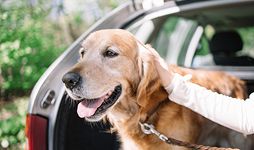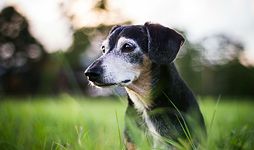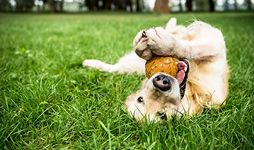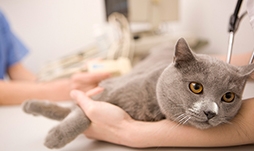The colour, shape and consistency of your dog’s poo can tell you a lot about their health. We’ve shared everything you might need to know about your dog's poo, including its colour, shape, smell and consistency, and when to think about contacting a vet for advice.
Remember that it is always important to clear up your dog's poo properly and safely, as it may contain harmful bacteria or parasites that could cause serious illness, particularly in young children or the elderly.
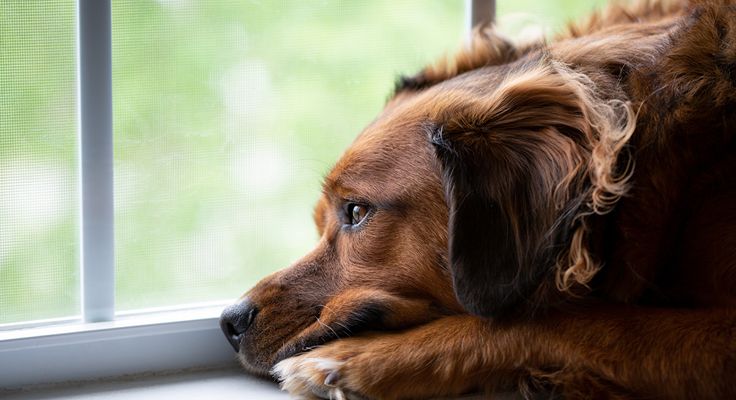
What should dog poo look like?
While every dog is different and their poo may vary, here’s a general guide to what your dog’s poo should look like:
- Colour – their poo should be a chocolate brown colour
- Shape – it should look like a log
- Consistency – the poo should keep its log shape, making it easy for you to pick up
- Size – this will depend on how much your dog eats and also their own size and breed
Dog poo colours and what they mean
Our in-house vet, Luke, has shared what different poo colours could mean:
- Grey or greasy may show an issue with the pancreas or the bile (from the gall bladder)
- Orange or yellow poo may show issues with the liver or gall bladder
- Black and tarry poo can mean bleeding in the stomach or small intestine
- Fresh red streaks of blood can mean a bleed in the large intestine
- Green poo can be from ingestion of grass or can mean a bile acid or gall bladder issue
- White flecks in the poo may be tapeworms
If you're concerned, you may want to contact your vet for advice. Don't forget that if you have pet insurance with us, you can use our 24/7 vetfone service to speak to a qualified vet nurse for advice at any time.
Dog poo consistency
A healthy dog's poo should resemble a moist log that holds its shape.
Dog poo and constipation
It could be a sign of constipation if your dog's poo is small, dry, hard – the poo may resemble pebbles in this way – and difficult for them to pass.
Dog poo and diarrhoea
All dog owners will likely come across diarrhoea at some point – it is very recognisable as poo that is looser than normal. The consistency can vary from thick but soggy to very runny and watery.
What causes constipation in dogs
A healthy dog should poo once or twice a day without difficulty. A dog who is constipated may not be able to poo at all or may be straining to do so. If they are able to pass any poo, it will likely be in small, hard lumps.
The more common causes of this are dietary issues, not drinking enough water and being less active. More serious causes can be things like metabolic diseases, tumours and disorders of the central nervous system.
How to help a constipated dog
If your dog is showing signs of constipation, make sure they are drinking plenty of water and that there is enough fibre in their diet. Try and keep them active, as not getting enough exercise may be part of the problem. Speak to a vet if you are worried about your dog's constipation.
What causes diarrhoea in dogs
Most causes of diarrhoea will be fairly ordinary and not a reason to be particularly worried – often it will simply be the case that your dog has eaten something they shouldn't have that has upset their tummy but won't cause any further harm. A change in diet may also cause some temporary diarrhoea.
More serious and less common reasons for diarrhoea include gut infections (bacterial, viral or parasitic), consuming something toxic or poisonous, bowel disease or a blockage of the gut.
Environmental factors or stressors such as dehydration or heatstroke can also cause diarrhoea. If your dog is stressed or anxious, they may also experience a bout of diarrhoea.
When to be worried about diarrhoea
If your dog has an underlying health condition, you should contact your vet as soon as possible. You should also do this if you have an elderly dog or a puppy.
For other dogs, reasons for concern include blood in the diarrhoea, repeated vomiting, lethargy (unusual tiredness), seizures, more frequent urination and increased thirst. You should contact your vet for advice if your dog shows any of these symptoms along with their diarrhoea.
How to help a dog with diarrhoea
For mild cases of diarrhoea, you can help your dog recover by replacing their usual food with bland foods such as boiled fish or chicken and white rice, though you should make sure this is in small amounts and over a regular period, such as every two hours.
Keep an eye on your dog and, if there is no more diarrhoea, start to mix their normal food with this bland food for a day or so before returning to their usual diet.
Make sure that you keep checking their poo for signs of diarrhoea or any other issues. Your dog should also be drinking water in this period, though this is best kept to small amounts – too much water at once may make them sick.
Unless the diarrhoea is accompanied by another issue, such as those discussed above, your dog should be just fine and back to their usual self within a couple of days. Diarrhoea is a common illness in dogs and is usually mild and temporary.
Blood in dog poo
It can be alarming for dog owners to see blood in their dog's poo, but it is often not a sign of anything serious.
If your dog is otherwise their usual self, it is most likely due to a minor issue.
Blood in the poo may show as
- red spots or streaks in an otherwise normal poo
- jelly-like blood in poo that is loose or runny; or
- poo that is overall black in colour.
It's always best to speak to your vet if you do see blood in your dog's poo, as they will be able to advise you. Having a photo or sample to share will be very helpful for this.
Worms in dog poo
Worms in dog poo are a fairly common issue and not usually a reason to worry.
Two of the most likely types of worms to appear in the poo are roundworms and tapeworms.
Roundworms will look like pieces of spaghetti, while tapeworms appear more like grains of rice. Roundworm eggs are not visible to the naked eye, so it is possible that your dog could have worms and normal-looking poo. Speak to your vet about regular worming.
You may also notice other symptoms at the same time, such as scooting, diarrhoea, vomiting and bloating.
If you suspect your dog has worms, you should contact your vet for advice. You will most likely need to provide a sample of your dog's poo for investigation.
Mucus in dog poo
Mucus in the poo is often a sign of an issue in the large intestine. Intestinal parasites or even inflammatory bowel disease can cause this. If your dog is acting normally, try feeding them a more bland diet for a couple of days and keep an eye on their poo to see if the situation improves.
If you are still concerned, or your dog is showing any other symptoms, contact your vet for advice.
Protecting your dog's health
Though we always want our dogs to be in the best of health, there are unfortunately going to be times for all dog owners when their dog becomes ill. This may be indicated by their unusual poo or by other symptoms.
Sometimes, this will mean that treatment is required. In these cases, having the right pet insurance cover could be a big help when it comes to unexpected vet costs at an already stressful time. With our basic, classic and premier cover options, you can choose the right option for you and your dog.
